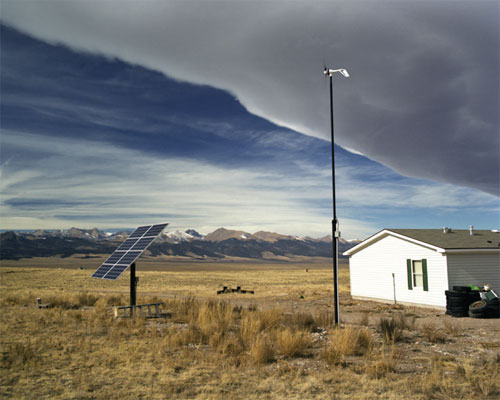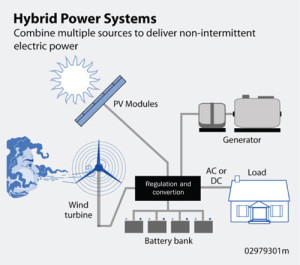
Living “off-grid” refers to living in a self-sustaining manner without reliance on one or more utilities. Some consider disconnecting from the electrical utility to be off-grid, while others take a more intense view and consider a truly off-grid application to be one that is disconnected from all public services (electricity, city sewer, water, waste disposal and even mail). For purposes of E3A, off-grid is concerned only with disconnecting from the electrical utility.
There are many reasons why people do not connect to the utility grid. For agricultural producers, off-grid applications are common for remote stock water facilities that are distanced from available electrical supply. Homeowners may also opt to be off-grid because the distance (and cost) of running electrical service to the home is prohibitive. Some homeowners pursue being off-grid out of concern for the environment and a desire to reduce dependence on fossil fuel-based sources of energy. Others like the idea of being more self-sufficient and being rid of monthly utility bills. No matter your motivation for considering off-grid living, there are a few facts about being off-grid that may help to determine whether it is right for you.
System Design
Design of an off-grid system can be complicated. In addition to considering one or more sources of electrical generation, you must also consider the use (load), storage, voltage, and quality of the electricity. In off-grid agricultural applications (such as stock water facilities) these considerations are not overly complicated. However, in a home, there are many system design considerations, including determining how to heat your living space and water. There are qualified off-grid system designers who can assist you in these decisions, but at present, finding a qualified designer may pose a major challenge. If you intend to design your own off-grid system, consider attending classes, such as those offered by Solar Energy International, to learn more about appropriate system design.
Space heating can be provided by propane, but can also be accomplished through building design and using solar thermal technologies. A building can generate natural heat and cooling using passive solar design principles. In passive solar design, the building has a northwest axis. In the northern hemisphere, the sun’s lower-angled, direct winter rays enter the south-facing wall’s windows. Thermal mass materials (typically masonry flooring) absorb the energy and radiate it back into the space as heat. Roof overhangs and awnings block the sun’s higher-angled, direct summer rays keeping the building cooler. Passive solar design buildings have high levels of insulation to help retain the conditioned air. This strategy is called “passive” solar because these design elements entail no moving parts. Passive solar buildings can include “active” elements such as fans for air distribution and heat recovery ventilators, etc. For existing buildings, solar air collectors can be used to generate heated air. They can be retrofitted into a wall or roof. They use the sun’s energy to heat individual rooms and supplement existing HVAC systems, or to pre-heat ventilation air (transpired solar collectors).
Off-grid-buildings can use propane or solar thermal technology to heat water. For more information on solar hot water systems, refer to the E3A Solar Hot Water folder. Be aware, however, that solar hot water systems typically used in colder climates do require electricity for controls and to pump liquids through the collectors.
Investment in Renewable Energy Technologies
Off-grid applications can utilize many modern conveniences, but still require at least one source of power. While petroleum-fueled generators can be used, it is more typical (and usually more cost effective) for off-grid applications to use renewable energy technologies. Solar and wind applications are commonly found in off-grid applications.
Batteries and Balance-of-System Equipment
Safe utilization of the electrical current generated in an off-grid application requires additional equipment to condition and transmit the electricity. This additional equipment can account for up to half of your total system cost (U.S. DOE, 2011). The amount of equipment and expense will vary according to your system design, but typical components of an off-grid system (especially in a home) include:
Batteries — When your renewable energy system is not producing energy (or is producing at low levels), you will need to rely upon stored energy for your needs. Batteries store the energy produced by renewable energy sources and the back-up generator. In off-grid applications, “deep cycle” batteries (generally lead-acid) are typically preferred. Deep cycle batteries can repeatedly charge and discharge up to 80 percent of their capacity without significant wear on the battery. Shallow charge batteries (like automotive) can only be drawn down by about 20 percent, and are not recommended. Deep-charge batteries can be expensive, but the amount of expense depends both on the amount of load (demand) the system will place on the battery and the amount of storage required. For example, some homeowners are comfortable with storing one to three days of electricity demand. Others may feel that they need to store more energy. For example, a homeowner with a wind and solar-based system in Montana or Wyoming may consider weather patterns – are there multiple days in the winter when temperatures are well below zero, the wind is not blowing and it is cloudy?
Homeowners also need to consider battery space and location. For health and safety reasons, batteries need to be stored in an area that accessible and well ventilated but isolated from living areas. New home construction can plan for a battery storage area. Existing structures may require retrofitting to accommodate batteries.
Charge Controllers — Charge control devices regulate the flow of electricity between the renewable energy generation source and the battery. The charge controller senses the demand for electricity and the charge of the batteries. When batteries are fully charged and there is no further need for electricity in the home, the controller will either stop the flow of electricity to the batteries, or will divert it into a “shunt” or “dump” load. In home applications, the dump load may be an electric water heater. Some rural residences use the dump load to heat livestock water tanks in winter months. When batteries are low, the controller will stop the electricity flow to the home until the batteries reach a certain level of charge. This feature extends the life of the batteries. Cost of charge controllers vary by the amount of load on the system and the features you select.
Inverters: Power Conditioning Equipment — Most renewable energy technologies generate direct current (DC) electricity. However, most electrical appliances in the United States run on 60 hertz alternating current (AC) electricity. Some off-grid applications use DC equipment or appliances, but especially in a home application, it is more typical for AC current to be used. Inverters serve these primary purposes:
• Conversion of constant DC power to oscillating AC power
• An Inverter/Charger converts DC to AC, but also converts a back-up generator’s AC into DC for charging batteries
• Regulates the frequency of the AC cycles to 60 cycles per second
• Manages voltage consistency (extent to which the output voltage fluctuates)
• Regulates the quality of the AC sine curve (whether the shape of the AC wave is jagged or smooth)
• Power quality is especially important if you intend to operate sensitive electronic equipment such as computers and high-definition televisions, which cannot withstand much power distortion.
Inverters range in cost based on the quality of the power you intend to use, as well as the features that you include in your power-conditioning package. The conditioning equipment you require is dependent on many factors and needs to match the voltage, phase, frequency and sine wave profiles of your generation source. A qualified off-grid system designer can help you to determine your needs.
Safety Equipment — You will need to ensure that your system has safety features installed. Three common safety elements are safety disconnects (which either disconnect the system in a generation malfunction, or can be disconnected when you are performing system maintenance), grounding equipment, and surge protectors.
Meters and Instrumentation — Meters and monitoring equipment enable you to track your generation system output, as well as battery charge and your consumption. Costs will vary based on the level of monitoring you desire.
Cost and Finance of the System
A key benefit of being off-grid for many consumers is getting rid of utility bills. However, as you consider living off-grid, do not forget that you may have up-front costs associated with installing your system. Upfront costs of off-grid systems tend to be higher than grid-connected renewable energy systems, especially as the additional system components add to the expense. You should also remember that you will have annual operation and maintenance expenses associated with your system. As part of your research process when considering living off-grid, be sure you consider how you will finance your system and what terms are available to you. Also, talk to your home mortgage lender. Some conventional lenders either do not offer loans or require additional appraisal requirements for off-grid homes.
 Back-up Generation and Hybrid Systems
Back-up Generation and Hybrid Systems
In order to maintain a certain level of battery charge and ensure constant availability of electricity, you will need a back-up generation source and/or a hybrid system. Hybrid systems utilize more than one renewable energy system (usually wind and solar) to provide more consistent electrical generation. As an example of how this pairing of systems works, when it is cloudy and stormy and the solar system output is less, the wind is likely to be blowing. While hybrid systems can provide more consistent power, off-grid homeowners often have back-up generators in place as well. Generators are used to recharge batteries and supply electricity to the home if the renewable energy systems are not operational, or if load demands draw the batteries down to the point where additional generation is needed to recover a level of charge.
Conservation as a Lifestyle in an Off-Grid Home
All off-grid systems need to consider conservation and storage of electricity. Unless you invest in a system that can accommodate every convenience, living off-grid magnifies those considerations. Here are a couple of examples:
- Decisions about what electricity to use may depend upon the amount of electricity available. Using a hair dryer while running the automatic coffee pot and microwaving something for breakfast may be too much load for your system at one time.
- You will need to continually monitor your system. Some monitoring, such as checking the charge of the batteries and ensuring that the system is generating electrical current, is done almost daily. Other monitoring, like water level of the batteries, can be done less frequently.
- You may need to invest in a propane-fueled refrigerator and propane-fueled electrical clothes dryer (or decide to forego a dryer and other appliances). Large electrical loads are not desirable in an off-grid home because of the amount of electricity required to support their operation.
Off-grid living is possible, but requires an increased awareness of energy consumption. System design is especially important. Do-it-yourselfers may welcome the challenge of researching and undergoing training to design an optimized system, but be aware that these are complex systems (if you intend to have modern conveniences) and selecting a qualified system designer may be your best option.


